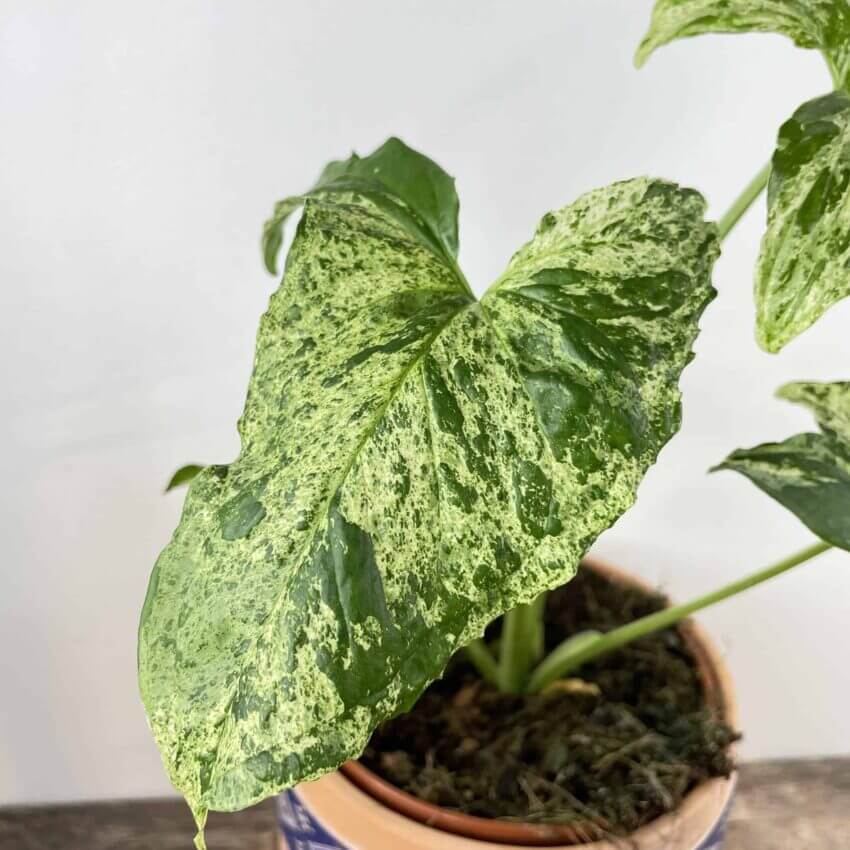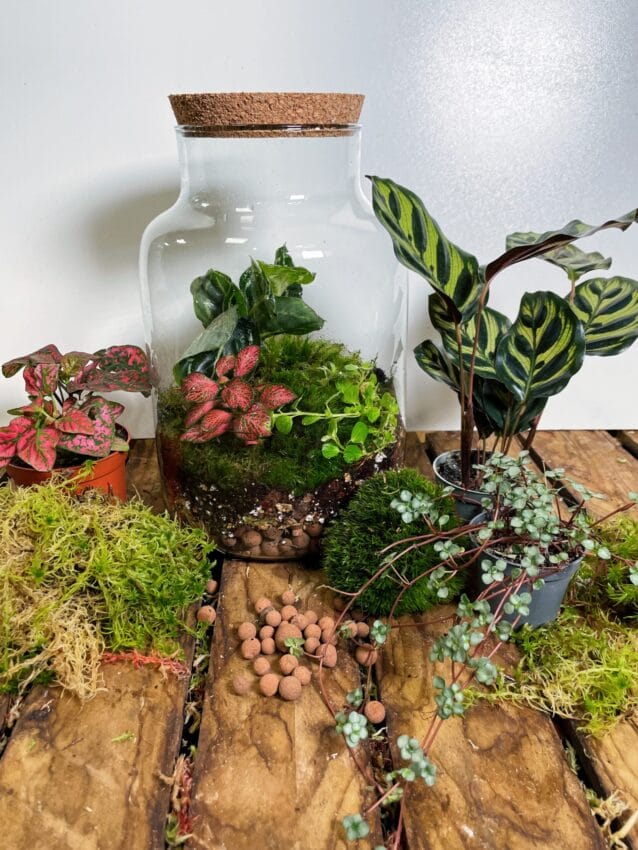About Syngonium
Syngonium is a magical species of plant known for its light and bright colours. There are around 35 different species that make up the genus which belongs to the Araceae (Arum) family, with only a small handful being domesticated and cultivated for houseplants. These delicate and beautiful woody vines can grow up to 20 metres in their natural habitats and can be found in the tropical forest of Southern Mexico, Panama, Costa Rica, Brazil and the West Indies.
Syngonium can dominate their natural environment with their ability to use aerial roots to grow on the forest floor. Once they stumble across a host tree, they will start to climb the trunk and continue their journey upwards.
These plants have become a fast favourite amongst houseplant collectors due to their strong air-purifying qualities. They have the ability to draw out pollutants in the air leaving it feeling clean and fresh. As well as pollutants, these plants can improve their own environment by reducing airborne microbes, and increasing the humidity in the surrounding area.
Some varieties of Syngonium can be incredibly rare and warrant high price tags. But there are few plants that can replicate the colour spectrum of these wonderfully tropical plants, leaving you in awe that somewhere out in a tropical rainforest there are such incredibly interesting plants growing wild.
Light
Syngonium, thrive in full/medium indirect light. Varieties with light-coloured foliage will require the highest indirect light levels to be able to maintain their colouration, this is due to their lack of chlorophyll meaning they will need more light to keep them thriving. These varieties will appreciate and tolerate small periods of the morning sun, no more than a couple of hours, which will help to boost their colour and keep them happy.
The less colourful varieties are one of the most tolerable to low light or partial shade conditions. While they won’t grow as quickly they can still happily survive under lower light.
The optimal location of Syngoniums will heavily depend on the species you have chosen, it’s always best to do some research before choosing the best position for your plant.
Humidity
All varieties of Syngonium that have been cultivated for houseplants originally come from tropical rainforests. Meaning that higher humidity levels will make them feel much more comfortable and will encourage vibrant and lush foliage. Their sweet spot is around 60% humidity, however, they will adapt to their environment and can tolerate the average home humidity level (40%), but they will still require regular heavy misting to really see the plant perform. If they don’t get enough humidity the delicate leaves will soon crisp up and start turning brown.
Water
Syngonium sits comfortably in the middle of the watering spectrum but is more thirsty than most. They like to have their soil kept slightly moist but not wet or soggy as this can lead to root rot and fungal infection. A continuous moist soil will be the ideal sweet spot. Syngonium is a vigorous grower throughout spring and summer and during these times it can absorb water incredibly quickly, so the plant shouldn’t be allowed to dry out completely as this will result in brown and crispy leaves that will not recover and stunt growth.
Soil
Syngonium prefers well-drained soil that can retain moisture between watering. The ideal soil mix for Syngoniums is nutrient-rich, allows for good aeration, is slightly acidic (6.2PH-7PH), and free-draining with a smidge of water retention. Most aroid potting mixes will be sufficient, but you can always add perlite for some additional drainage, and vermiculite for added water retention. With a combination of these, you can provide the best environment for your plant to thrive.
Grab Your Ready-To-Use Aroid Mix Here
Feed
Syngonium will need regular feeding to keep the nutrients at optimal levels in the soil and allow your plant to thrive. Like most houseplants, to promote healthy roots, stems, and leaves they will need a steady supply of nitrogen, phosphorus, and potassium. The most important is nitrogen to keep their leaves bright and looking their best.
A good liquid houseplant feed can be applied every 2-4 weeks during the growing season. The liquid feed can be diluted to around half strength when applied. There’s no need to feed during the winter, light levels are much lower and the plant won’t use as much energy to grow.
Repotting
It’s best to repot your Syngonium once the roots fill their pot. Depending on the size of the plant, you may find yourself repotting once per year. That being said, they don’t mind being slightly pot-bound, they can survive like this for a little while, as long as they are receiving enough nutrients via feeding.
The pot size can increase by one step every year for as long as you have the space to house the new influx of growth. If you have reached your maximum pot size you will need to top-dress the plant once a year with a fresh layer of soil to replenish the nutrients.
The best time to repot your Syngonium is when spring arrives. Outside temperatures will rise and the daylight hours will increase. When this happens your Syngoniums will react quickly to the environmental change and start producing lots of new foliage growth.
You will need to pick a pot with good drainage, we don’t want water hanging around the roots.
Next, fill a third of the way up with an Aroid Potting mix. Place the root ball of the plant in the centre of the pot.
If your Syngonium is maturing and starting to look more like a vine, now would be a good time to add a moss pole. It’s important to use a moss pole because it acts as a natural climbing frame.
Once you’ve got the plant and/or moss pole in place, fill the pot with the rest of your potting mix and firm down the soil.
When you’ve finished and got your plant back in the perfect spot you can give it a thorough watering to settle the plant into its new pot. Keep a close eye on it for the first couple of weeks and then relax back into your normal watering and feeding schedule.
Some Useful Video On How To Care For & Install Your Moss Pole!
Pruning & Propagating
Due to the fast-growing nature of these plants, it’s useful to trim them back to keep them looking tidy. It’s best to keep the new growth trimmed back throughout the spring and summer if you are happy with the size of your plant.
REMEMBER – Always use clean and sharp pruning scissors!
Syngonium is a great plant to propagate as cuttings take quite easily and will start producing a new root system relatively quickly. There are two effective methods to start propagating from your plant:
Cuttings
If you prune back your Syngonium at the node, you will end up with a mass of great cutting material. Simply place your cuttings in a glass of rainwater and wait for up to 2-4 weeks to start seeing signs of new roots. You will need to regularly change the water to avoid algae. Once you have substantial root growth you can place the cutting into a small pot of Aroid Potting mix and keep it in a high temperature and humidity environment.
You can also put your cutting straight into a jar with fresh sphagnum moss. This is probably the easiest way to propagate as it involves the least steps. Simply take your cutting at the node, find a jar or pot preferably with no drainage holes, fill it up with fresh moss and nestle your cutting in the centre. Fill up the jar with water so the moss has been evenly watered and then drain out all excess water making sure not to leave any at the bottom of the jar when standing upright. Now just keep an eye on your new cutting, checking the moss every couple of days to ensure it hasn’t dried out.
Keep a close eye on these small pots as they will dry out quickly!
Air layering
The first step is to find a node (this is the point on the stem where a leaf is attached) with an aerial root growing underneath. Then using a clean sharp knife or pruning scissors make a small notch just below the root in the stem, it doesn’t have to be very deep. By making a small notch you are encouraging growth hormones in that specific area. Then cover the aerial root, the notch, and the node in a thick layer of damp sphagnum moss. Wrap around the moss with plastic wrap and then tie it over with string to make sure it’s held in place. You will need to keep the moss damp at all times and don’t allow it to dry out. After a month or so you should start seeing signs of new aerial roots appearing in the moss. At this point, carefully cut off the piece of plant and move it into a pot with Aroid Potting mix.
Troubleshooting & Tips
- If your Syngonium is becoming floppy but not showing any other signs of distress, it is likely time to install a moss pole to help support the climbing vine.
- If your Syngonium is becoming leggy and leaf growth is stunted, this is an indication that it isn’t getting enough light, it will be best to find a brighter location.
- If your plant is quickly developing yellow leaves including the newer growth, this is an indicator of too much direct light, move it away from any areas of direct light.
- The sudden development of yellow leaves that quickly become brown or mushy can be a sign of overwatering which in most cases could also lead to root rot.
- If the edges of your plant are starting to become brown, this can be a sign of temperature shock, which can occur from sudden changes in ambient temperature or persistent cold drafts but can also develop if the plant is watered with cold water causing shock to the root system.
- If the tips of the leaves are starting to turn brown and slightly crispy this is a sign that the plant needs more humidity.
- If the edges of the leaves are turning brown and starting to curl inwards this is a sign that the plant isn’t getting enough water.
Toxicity
Syngonium can be poisonous to people but more so to pets if ingested. These plants don’t pose any serious risk but can still cause vomiting, difficulty swallowing, abdominal pain, and irritation. So it’s best to keep these plants out of reach.
Species

Syngonium Erythrophyllum Red Arrowhead
Another gorgeous climbing Syngonium, the Red Arrowhead produces rich dark glossy green leaves with a striking deep ruby red underside that offers a wonderful contrast of dark colour amongst a sea of greenery. While this plant is a climber if kept trimmed back it can create a fantastic compact plant.




Syngonium Pink Splash
This Syngonium makes for a great beginners plant, it’s easy to care for, a vigorous grower and is beautifully delicate. The relatively small arrow-shaped leaves produce pink variegation which can come in splashes over the lighter green leaves or in some cases engulf most of the leaf creating a bright and striking plant.



Syngonium Mottled
Also known as Syngoniumm Mojito is a rare and sort after variety. A plant of true beauty, this leaf is a rich jungle green that grows into wide paddle shapes. The variegation of the plant is what makes it so special, it produces splashes and dashes of creamy white variegation covering large areas of the leaf, hence the name mottled.



If you enjoyed this guide head over to Articles & Blogs to learn more or check out our YouTube for even more useful information!





